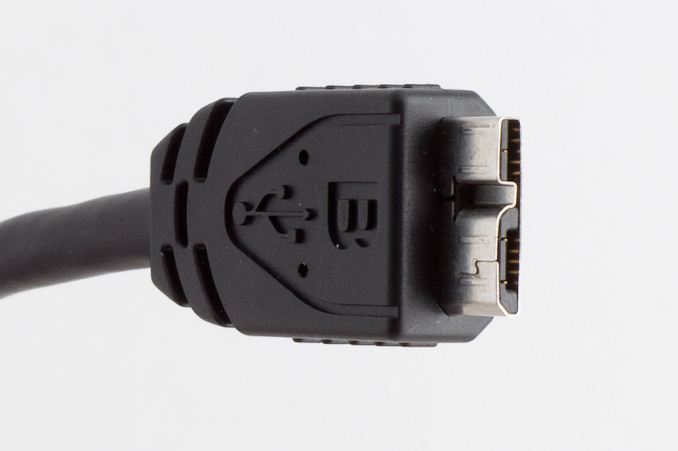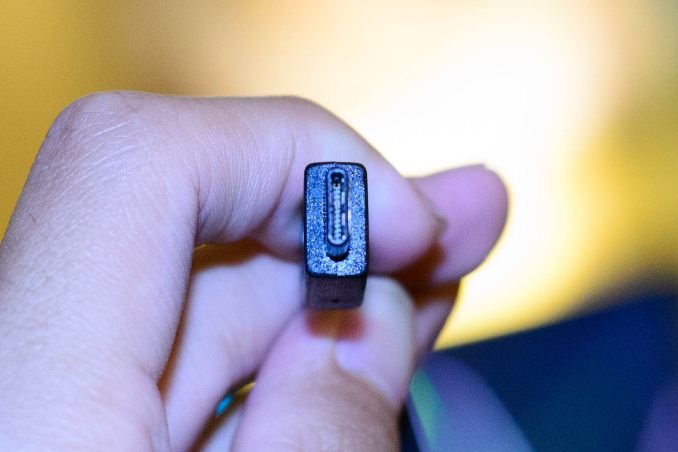USB Power Delivery v2.0 Specification Finalized - USB Gains Alternate Modes
by Brett Howse on September 17, 2014 8:00 AM EST
The last while has been a busy time for the USB 3.0 Promoters Group, with the new USB 3.1 Type-C Connector detailed last month. Joshua was able to get a hands on with the new connector at IDF last week. With support for up to 10 Gbps, a new reversible Type-C connector, and up to 100 watts of power delivery, the USB group is trying to expand the already universal connector to be able to do much more than is possible with the current specification. To fulfill this mandate, they have now finalized the USB Power Delivery v2.0 spec, and the Billboard Device Class v1.0 spec.
When USB was first introduced, the thought was that it would be primarily a data interface, with a limited amount of power delivery which was generally used to power the electronics of certain devices. The initial specification for USB only had provisions for 0.75 watts of power – 150 mA at 5 V. USB 2.0 bumped that to 500 mA, or 2.5 watts, and USB 3.0 specified 900 mA at 5 V, or 4.5 watts. All of these specifications allow for power as well as data transmission at the same time. In addition, there was also a Battery Charging specification which allows up to 1.5 A at 5 V for a maximum of 7.5 watts of power but with no data transmission available. The jump from 7.5 watts to 100 watts of the new specification is a huge increase, and one that cannot be done with just an amperage increase on the system as was done in the previous versions of USB. Version 3.1 now supports 5 V, 12 V, and 20 V on the pins to allow the higher power output without excessive current, but even the current has been increased to a maximum of 5 A which is much higher than before.
 The inelegant USB 3.0 Micro-B connector
The inelegant USB 3.0 Micro-B connector
USB Power Delivery is designed to increase the flexibility of USB, by providing enough power for many more devices, while at the same time still allowing data delivery. It is also even more flexible, due to a couple of changes. First, the direction of power delivery is no longer fixed. Imagine a tablet with a keyboard attached. The keyboard can have a battery, and the battery can be charged through the data connection, but when the tablet is unplugged from its charger, the power flow can reverse and the tablet can now be powered by the keyboard. Another example is a laptop with six USB ports. The USB ports can be used for peripherals, or, a USB charger can be connected to any port to charge the laptop. Dedicated charging connectors will no longer be required.
 The reversible USB 3.1 Type-C connector
The reversible USB 3.1 Type-C connector
Another change is that all devices must now negotiate the amount of power required, and that can be renegotiated if another devices requires additional power. A good scenario would be if you have a laptop, and you are charging your phone on one of the USB ports. The phone would be pulling the maximum amount of power it can in order to charge quickly. If you then plug in a USB RAID array, it will need additional power at the start in order to get all of the disks spinning, but then can be lowered to a steady state. The system can lower the power delivery to the phone, provide it to the RAID array, and then move it back to the phone when the power is available.
The final key is that the Power Delivery specification is not just for power, nor is it just for USB. The Power Delivery Specification allows Alternate Modes to be defined, and the system can negotiate to enable these modes, enter them, and exit them. These modes will be defined outside the scope of USB-IF specifications using Structured Vendor Defined Messages. This allows the ability to reconfigure some of the pins a USB Type-C connector exposes and will allow the cable to be used for many different purposes rather than just for USB.
This leads us to the second specification – the Billboard Device Class. This specification outlines the methods used to communicate the Alternate Modes supported by the Device Container to a host system. It includes descriptors which can be used to provide support details in a human-readable format. What it does not contain is the methodology to switch to the Alternate Mode – that is done in the Power Delivery specification itself. The Billboard Device Class will allow a device which supports an Alternate Mode to connect to a host which does not support that mode, and then inform the user why it does not work without having silent failures, and for this reason all Billboard Devices must support USB 2.0 as a minimum.
This new framework could open the ubiquitous USB cable up to an entirely new array of devices and functions. One possibility that the USB-IF mentions in the specification is a theoretical means for PCI-E over USB. I’ve already given the example of a tablet with a battery in the keyboard, but a laptop could be connected to a monitor which can also charge the laptop. Much more power hungry devices can be connected to a USB port as well, including printers and high speed storage. All of this was defined with a graceful fail as well, so the user is not stuck wondering why his device is not functioning any longer.
The new Alternate Modes have quite a potential, and with the increased power capabilities of USB 3.1 and the Power Delivery Specification, it will be very interesting to see how these capabilities are taken advantage of in future devices.
Source: USB-IF












46 Comments
View All Comments
DanNeely - Wednesday, September 17, 2014 - link
On the desktop the kicker is likely to be that unless they create it on the mobo, there won't be a source of +20V power for the 100W mode. Unless it takes off beyond laptops (eg 20V @1A for new faster charging tablets); I suspect that desktop ports will max out at 12V @ 5A = 60W; supplying that to a port or two should be doable; but without a crazy huge PSU just for mass USB charging doing it to 10 or so will be impossible.Impulses - Thursday, September 18, 2014 - link
So looking forward to figuring out what the charging ports are in desktops, laptops, hubs, displays etc... And then finding out whether it works at all regardless.Gigaplex - Thursday, September 18, 2014 - link
It's not hard to step up voltage levels.iwod - Wednesday, September 17, 2014 - link
I wish they could do a USB 3.3 where they just have all these spec required and Type-C by default.HisDivineOrder - Wednesday, September 17, 2014 - link
I think of all the problems I have with different USB implementations over the years. That's from USB 1 all the way to USB 3.0 (or what I like to call, USB 3 Beta because 3.1 is the 3 we all deserved, the USB 3 post-Thunderbolt, post-Lightning).So I think of all those incompatibilities I have had over the years when USB devices didn't mesh well with one chipset or another, when bugs would happen, and the device wouldn't run.
Now I think of 2-way power of absurd amounts going one way or another at the sole discretion of either the chipset of one device or another. I imagine how that might go wrong. How it might go really, really wrong if "incompatibilities" occur.
And I imagine suddenly the very real possibility of some device I'm trying to use draining my laptop's battery rapidly. I imagine all the ways in which a cheap USB chipset (and believe that all USB chipsets will be cheap in no time at all) is going to be capable of really screwing up things now.
Do I trust the USB chipset on my Seagate external hard drive to know better than to do what it shouldn't? No.
No, I do not. So USB 3 final (aka USB 3.1) sounds like they're making a bet that everyone will do everything they're supposed to do, which flies completely in the face of what has happened with every version of USB since USB has existed.
Why do these people always ask themselves if they CAN do a thing without first asking if they SHOULD do a thing?
supgk - Wednesday, September 17, 2014 - link
Just wait for Type D.... out in 2 years or so.So many devices still coming out today use a mix of type B, Mini-B and Micro-B cables around so I don't think type C will catch on anytime soon.
It's really terrible, just went on holiday thinking I had brought along a Micro-B.. but wrong, it was a Mini.. had to buy another one. USB is garbage.
SirKnobsworth - Wednesday, September 17, 2014 - link
And this is exactly the reason they are introducing the type c connector. They've tried to keep backwards compatibility for a long time, but after the mess that was USB 3.0 connectors it's apparent that what's needed is a fresh start. Of course the transition period will be a bit painful but once it's done we'll all be better off. The type c connector includes a fair bit of future-proofing so it should stay around for a while. Remember that the type A connector has been around for nearly 20 years and included almost no future-proofing.tuxRoller - Wednesday, September 17, 2014 - link
Could you clarify: "One possibility that the USB-IF mentions in the specification is a theoretical means for PCI-E over USB."I didn't notice that mentioned in the link provided. Presumably this would involve encoding the pcie protocol into the USB protocol, this it would have tremendous overhead. Perhaps your point was that the USB connector/cable and the Alternate Modes standard could be used to employ pcie natively? How would that be possible without creating a new host controller? I know that usb3/xHCI stated putting much more functionality into the controllers but I didn't think they are particularly flexible as far as configuration goes.
SirKnobsworth - Wednesday, September 17, 2014 - link
It's in the type c connector specification, not the power delivery specification. The scenario they describe is using the connector's extra pins for a dedicated PCIe x1 link.tuxRoller - Wednesday, September 17, 2014 - link
"The final key is that the Power Delivery specification is not just for power, nor is it just for USB. The Power Delivery Specification allows Alternate Modes to be defined"That's what I was basing my understanding on. It says it allows "reconfiguration" of pins. That still seems to be under the PD2 scheme.
I still don't understand how they can use those pins without making changes to the host controller (the xHCI might allow enough flexibility for this, but it's really not clear to me).